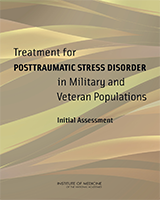NCBI Bookshelf. A service of the National Library of Medicine, National Institutes of Health.
Prior to the military conflicts in Iraq and Afghanistan, wars and conflicts have been characterized by such injuries as infectious diseases and catastrophic gunshot wounds. However, the signature injuries sustained by United States military personnel in these most recent conflicts are blast wounds and the psychiatric consequences to combat, particularly posttraumatic stress disorder (PTSD), which affects an estimated 13 to 20 percent of U.S. service members who have fought in Iraq or Afghanistan since 2001. PTSD is triggered by a specific traumatic event - including combat - which leads to symptoms such as persistent re-experiencing of the event; emotional numbing or avoidance of thoughts, feelings, conversations, or places associated with the trauma; and hyperarousal, such as exaggerated startle responses or difficulty concentrating. As the U.S. reduces its military involvement in the Middle East, the Departments of Defense (DoD) and Veterans Affairs (VA) anticipate that increasing numbers of returning veterans will need PTSD services. As a result, Congress asked the DoD, in consultation with the VA, to sponsor an IOM study to assess both departments' PTSD treatment programs and services. Treatment for Posttraumatic Stress Disorder in Military and Veteran Populations: Initial Assessment is the first of two mandated reports examines some of the available programs to prevent, diagnose, treat, and rehabilitate those who have PTSD and encourages further research that can help to improve PTSD care.
Contents
- THE NATIONAL ACADEMIES
- COMMITTEE ON THE ASSESSMENT OF ONGOING EFFORTS IN THE TREATMENT OF POSTTRAUMATIC STRESS DISORDER
- Reviewers
- Preface
- Acronyms
- Summary
- 1. Introduction
- 2. History, Diagnostic Criteria, and Epidemiology
- 3. Neurobiology
- 4. Programs and Services for PTSD in the Department of Defense and the Department of Veterans Affairs
- THE DEPARTMENT OF DEFENSE HEALTH CARE SYSTEM
- MENTAL HEALTH CARE IN THE DEPARTMENT OF DEFENSE
- TRANSITIONING BETWEEN THE DEPARTMENT OF DEFENSE AND THE DEPARTMENT OF VETERANS AFFAIRS HEALTH CARE SYSTEMS
- THE DEPARTMENT OF VETERANS AFFAIRS HEALTH CARE SYSTEM
- MENTAL HEALTH CARE IN THE DEPARTMENT OF VETERANS AFFAIRS
- COLLABORATIVE EFFORTS BETWEEN THE DEPARTMENT OF DEFENSE AND THE DEPARTMENT OF VETERANS AFFAIRS
- RESEARCH IN THE DEPARTMENT OF DEFENSE AND THE DEPARTMENT OF VETERANS AFFAIRS
- COST CONSIDERATIONS
- SUMMARY
- REFERENCES
- 5. Prevention
- 6. Screening and Diagnosis
- 7. Treatment
- 8. Co-Occurring Psychiatric and Medical Conditions and Psychosocial Complexities
- 9. Access to Care
- 10. Findings and Recommendations
- APPENDIXES
This study was supported by Contract No. W81XWH-10-C-0290 between the National Academy of Sciences and the Department of Defense. Any opinions, findings, conclusions, or recommendations expressed in this publication are those of the author(s) and do not necessarily reflect the view of the organizations or agencies that provided support for this project.
Suggested citation:
IOM (Institute of Medicine). 2012. Treatment for posttraumatic stress disorder in military and veteran populations: Initial assessment. Washington, DC: The National Academies Press.
NOTICE: The project that is the subject of this report was approved by the Governing Board of the National Research Council, whose members are drawn from the councils of the National Academy of Sciences, the National Academy of Engineering, and the Institute of Medicine. The members of the committee responsible for the report were chosen for their special competences and with regard for appropriate balance.
- NLM CatalogRelated NLM Catalog Entries
- Veteran and Military Mental Health Issues.[StatPearls. 2024]Veteran and Military Mental Health Issues.Inoue C, Shawler E, Jordan CH, Moore MJ, Jackson CA. StatPearls. 2024 Jan
- Review Treatment for Posttraumatic Stress Disorder in Military and Veteran Populations: Final Assessment[ 2014]Review Treatment for Posttraumatic Stress Disorder in Military and Veteran Populations: Final AssessmentCommittee on the Assessment of Ongoing Efforts in the Treatment of Posttraumatic Stress Disorder, Board on the Health of Select Populations, Institute of Medicine. 2014 Jun 17
- Combat duty in Iraq and Afghanistan, mental health problems and barriers to care.[US Army Med Dep J. 2008]Combat duty in Iraq and Afghanistan, mental health problems and barriers to care.Hoge CW, Castro CA, Messer SC, McGurk D, Cotting DI, Koffman RL. US Army Med Dep J. 2008 Jul-Sep; :7-17.
- Review Combat TBI: History, Epidemiology, and Injury Modes.[Brain Neurotrauma: Molecular, ...]Review Combat TBI: History, Epidemiology, and Injury Modes.DePalma RG. Brain Neurotrauma: Molecular, Neuropsychological, and Rehabilitation Aspects. 2015
- Review Acute Pathophysiology of Blast Injury—From Biomechanics to Experiments and Computations: Implications on Head and Polytrauma.[Brain Neurotrauma: Molecular, ...]Review Acute Pathophysiology of Blast Injury—From Biomechanics to Experiments and Computations: Implications on Head and Polytrauma.Chandra N, Sundaramurthy A. Brain Neurotrauma: Molecular, Neuropsychological, and Rehabilitation Aspects. 2015
- Treatment for Posttraumatic Stress Disorder in Military and Veteran PopulationsTreatment for Posttraumatic Stress Disorder in Military and Veteran Populations
- Homo sapiens purinergic receptor P2X 5 (P2RX5), transcript variant 4, mRNAHomo sapiens purinergic receptor P2X 5 (P2RX5), transcript variant 4, mRNAgi|1675035743|ref|NM_001204519.2|Nucleotide
Your browsing activity is empty.
Activity recording is turned off.
See more...
